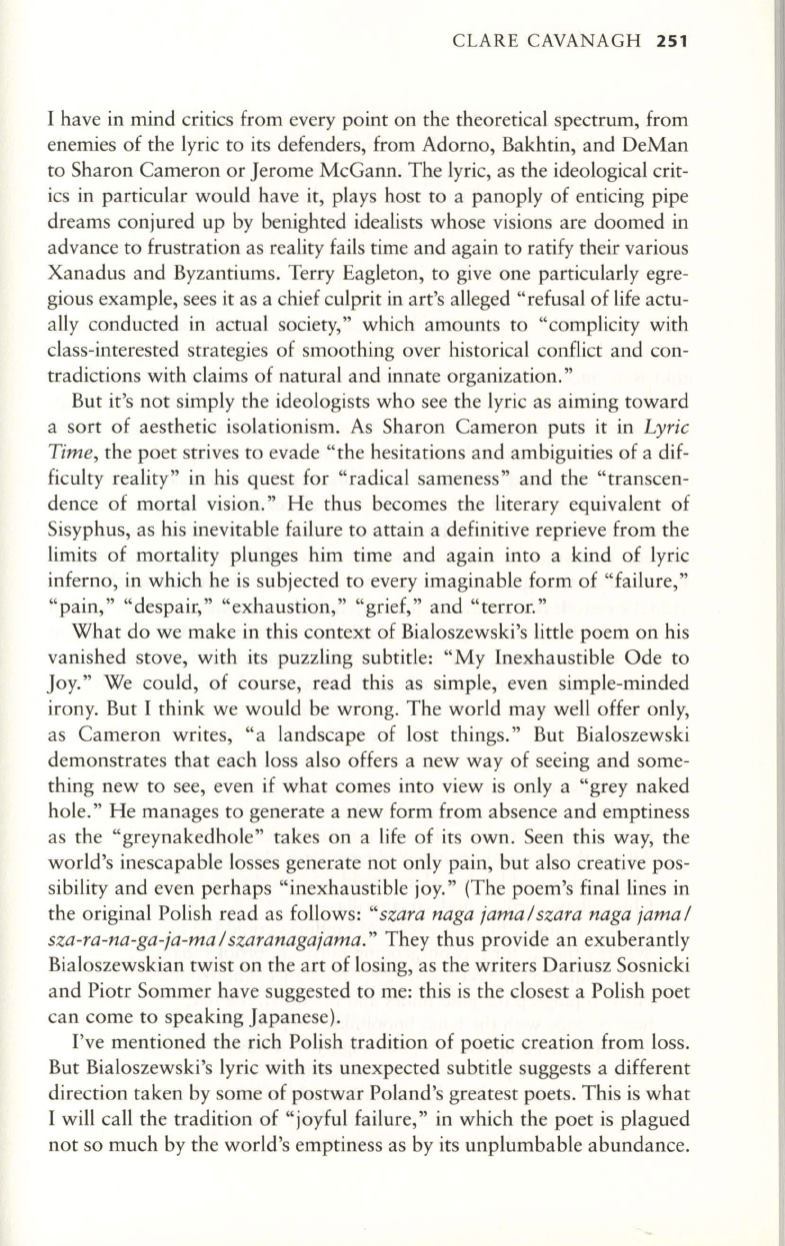
CLARE CAVANAGH
251
I have in mind critics from every point on the theoretical spectrum, from
enemies of the lyric to its defenders, from Adorno, Bakhtin, and DeMan
to Sharon Cameron or Jerome McGann. The lyric, as the ideological crit–
ics in particular would have it, plays host to a panoply of enticing pipe
dreams conjured up by benighted idealists whose visions are doomed in
advance to frustration as reality fails time and again to ratify their various
Xanadus and Byzantiums. Terry Eagleton, to give one particularly egre–
gious example, sees it as a chief culprit in art's alleged "refusal of life actu–
ally conducted in actual society," which amounts to "complicity with
class-interested strategies of smoothing over historical conflict and con–
tradictions with claims of natural and innate organization."
But it's not simply the ideologists who see the lyric as aiming toward
a sort of aesthetic isolationism. As Sharon Cameron puts it in
Lyric
Time,
the poet strives to evade "the hesitations and ambiguities of a dif–
ficulty reality" in his quest for "radical sameness" and the "transcen–
dence of mortal vision." He thus becomes the literary equivalent of
Sisyphus, as his inevitable failure to attain a definitive reprieve from the
limits of mortality plunges him time and again into a kind of lyric
inferno, in which he is subjected to every imaginable form of "failure,"
"pain," "despair," "exhaustion," "grief," and "terror."
What do we make in this context of Bialoszewski's little poem on his
vanished stove, with its puzzling subtitle: "My Inexhaustible Ode to
Joy." We could, of course, read this as simple, even simple-minded
irony. But I think we would be wrong. The world may well offer only,
as Cameron writes, "a landscape of lost things." But Bialoszewski
demonstrates that each loss also offers a new way of seeing and some–
thing new to see, even if what comes into view is only a "grey naked
hole." He manages to generate a new form from absence and emptiness
as the "greynakedhole" takes on a life of its own. Seen this way, the
world's inescapable losses generate not only pain, but also creative pos–
sibility and even perhaps "inexhaustible joy." (The poem's final lines in
the original Polish read as follows :
"szara naga jama
/
szara naga jama /
sza-ra-na-ga-ja-ma
/
szaranagajama."
They thus provide an exuberantly
Bialoszewskian twist on the art of losing, as the writers Dariusz Sosnicki
and Piotr Sommer have suggested to me: this is the closest a Polish poet
can come to speaking Japanese).
I've mentioned the rich Polish tradition of poetic creation from loss.
But Bialoszewski's lyric with its unexpected subtitle suggests a different
direction taken by some of postwar Poland's greatest poets. This is what
I will call the tradition of "joyful failure," in which the poet is plagued
not so much by the world's emptiness as by its unplumbable abundance.


